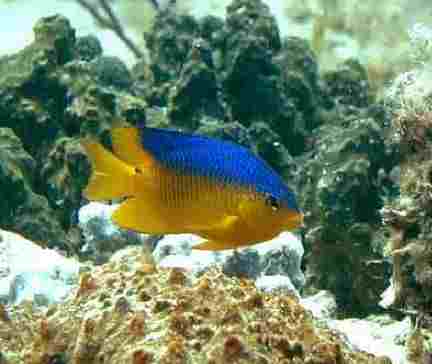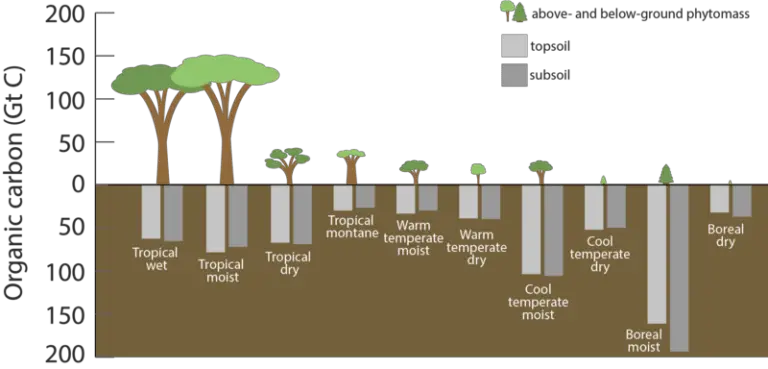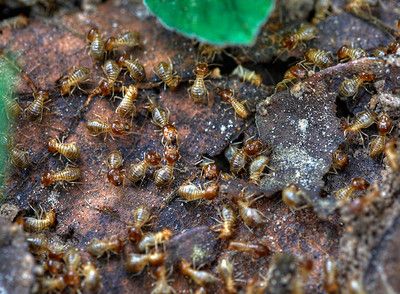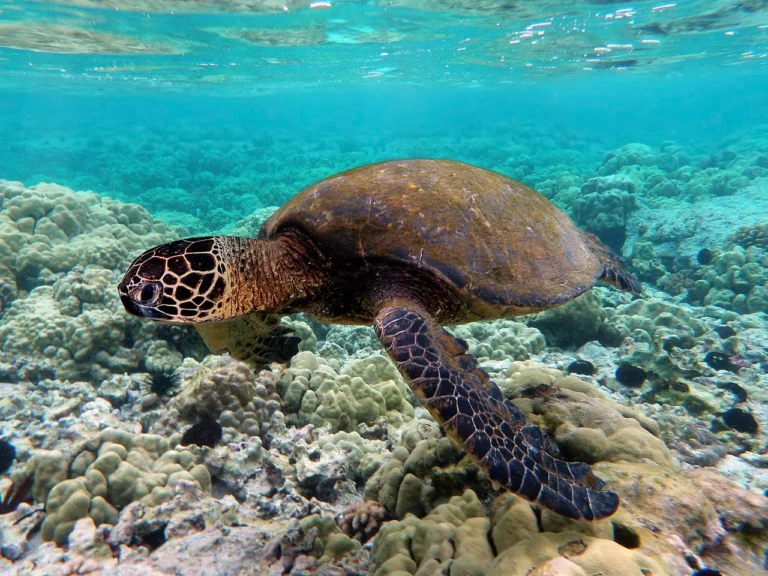Ocean Energy Pyramid Trophic Levels and Transfer Processes
Ocean energy pyramid comprises of producers, primary consumers, secondary consumers, tertiary consumers, quaternary consumers and decomposers, as well as the processes that govern the flow of chemical energy between these groups.
This article discusses the ocean energy pyramid in terms of its trophic levels and transfer processes, as follows;
1). Ocean Producers (as components of the Ocean Energy Pyramid)
Ocean producers, also referred to as marine autotrophs, can be described as the foundation of energy flow within the marine ecosystem.
This is because organisms within this category, utilize solar energy (in the form of light) and other resources to transform inorganic compounds into organic biomass, through the process of photosynthesis [5].
Primary producers in the ocean include; benthic algae, phytoplankton, cyanobacteria, and seagrasses [3].

Role of Ocean Producers in Energy Flow
All trophic models of the marine ecosystem, including food chain, energy pyramid, biomass pyramid and food web; are built from interactions involving some form of chemical energy transfer.
Understanding the ocean energy pyramid is possible only by evaluating the respective contributions of different organic groups or trophic levels, to energy flow in the biome as a whole.
The role of ocean producers in energy flow can be assessed using concepts like photosynthesis, primary production, trophic transfer, and energy losses; all of which portray different aspects of the flow, acquisition, assimilation and conservation of bioenergy by producers. They are discussed in the outline below;
1. Photosynthesis occurs when producers capture and utilize sunlight, nutrients and carbon dioxide, to create oxygen and starchy organic compounds [7].
This process forms the basis of the ocean energy pyramid by producing energy and organic matter that can be transferred to other organisms for their sustenance.
2. Primary production is the overall outcome of the photosynthetic process for ocean producers.
It can be defined as the production of chemical energy from solar radiation by autotrophs.
The energy produced is stored in the form of organic compounds, which are transferred from one trophic level to another through various forms of feeding.
3. Producers are the occupiers of the first trophic level in the food chain, and transfer energy to herbivores (primary consumers) which consume them. This energy transfer sequence proceeds in similar manner as it moves up the trophic levels.
Producers and Energy Loss During Trophic Transfer, in the Ocean Energy Pyramid
As energy moves through the trophic levels in the food web, loss of energy at each typically occurs at every point of transfer.
This loss can be attributed to multiple factors, such as hot climate, inefficiencies in energy conversion, and energy that diffuses during respiration and other metabolic activities.
As a result of such losses, the total amount of available energy in the ocean decreases as it flows from one trophic level to the next, resulting in a tapered energy pyramid with larger amounts of energy at the base (producers) and decreasing amounts further up the hierarchical structure.

An Overview of Producers in the Ocean Energy Pyramid
Producers are the autotrophs found at the base of the energy pyramid, whose role is to transform sunlight and inorganic raw materials into chemical energy through photosynthesis.
The producers in the ocean ecosystem include microscopic autotrophs like cyanobacteria, as well as vascular and non-vascular plants called halophytes.
Examples of producers in the trophic pyramid include;
1. Diatoms
2. Dinoflagellates
3. Kelp
These organisms are centrally involved in sustaining marine ecosystems and supporting the diversity of life in their habitat.
2). Ocean Primary Consumers
Ocean primary consumers, also referred to as marine herbivores, are heterotrophic organisms that directly feed on the marine producers (autotrophs) to obtain their nutrients and energy.
These primary consumers are also involved in energy flow within the marine ecosystem, because they are able to assimilate and subsequently transfer the stored energy in algae and vascular marine plants to non-herbivorous consumers that occupy higher trophic levels.
Role of Ocean Primary Consumers in Energy Flow
The role of ocean primary consumers on energy flow within the ecosystem, can be analyzed in terms of herbivorous feeding patterns, energy transfer, and loss of bioenergy. These are discussed summarily below;
1. Herbivory by primary consumers involves their grazing on marine plants like seaweeds, as well as their consumption of phytoplankton, and the assimilation of organic matter in these producers. Energy extracted from these plant materials is use by ocean primary producers to fuel their own growth and survival.
2. Energy transfer in the ocean energy pyramid, can be said to commence at the point where primary consumers feed on producers.
Primary consumers assimilate the stored energy in plant tissues into their bodies.
This energy assimilated by primary consumers, becomes available to non-herbivorous consumers in the overlying trophic level, which include carnivores and omnivores.
3. Trophic transfer occurs as energy flows across trophic levels due to autotroph consumption by primary consumers, and subsequent predation on primary consumers by higher (secondary, tertiary) consumers.
In this process of trophic transfer, some energy is continually lost to transfer inefficiencies, environmental influences, and metabolism.
Energy loss during trophic transfer also affects primary consumers. This loss is mainly as a result of the factors highlighted below;
3a). Metabolic processes lead to energy loss by primary consumers, which utilize energy for their metabolism. In the process, energy is converted into heat and dissipates, so that it is not available for transfer to higher trophic levels.
3b). The conversion efficiency with which consumed energy is transformed into biomass, is not 100% [9]. Some of it becomes waste energy which is lost, thereby limiting the amount of energy-resource that can be conveyed successfully to the next trophic level.
3c). Heat losses during physiological processes and cellular respiration, reduce the total energy available in the trophic level occupied by primary consumers.
Examples of Primary Consumers in the Ocean
Primary consumers in the ocean include various herbivorous and phytoplankton-eating marine organisms, such as;
1. Copepods
2. Krill
3. Damselfish [4]
4. Sea urchins

3). Ocean Secondary Consumers (as components of the Ocean Energy Pyramid)
Ocean secondary consumers are organisms that typically occupy the third trophic level pf the ocean energy pyramid or marine food chain.
Like other marine organisms, they are involved in energy flow within the oceanic habitat, through the act of preying upon herbivores (primary consumers). This implies that they obtain energy indirectly from producers (like algae and marine vascular plants).
Role of Ocean Secondary Consumers in Energy Flow
The role of ocean secondary consumers in energy flow can be evaluated based on predation, energy transfer and losses of energy, as discussed below;
1). Ocean secondary consumers carry out predation as a feeding behavior, because they are mostly carnivorous (or omnivorous) organisms that feed on primary consumers or other sources of animal matter. They depend on the energy assimilated from the tissues of the organisms they consume, for their own nutrition.
2). By consuming animal matter, secondary consumers contribute to energy transfer in the ecosystem.
They indirectly assimilate the energy obtained from producers, in the biomass of primary consumers. This energy is then used for their own reproduction and growth.
3). Trophic transfer from secondary consumers occurs when they become prey for tertiary consumers (or apex predators). This phase of trophic transfer, causes energy to be further transferred up the energy pyramid, with some losses occurring in the process.
Energy Loss by Secondary Consumers, during Trophic Transfer
Energy loss occurs in the process of trophic transfer from primary to secondary consumers, as well as from secondary to tertiary consumers.
Some of the factors that contribute to energy loss by secondary consumers are; trophic transfer inefficiency, heat production, and the presence of indigestible materials. They are discussed below;
1). Inefficiency of energy transfer causes losses, because energy is not transferred with 100% efficiency across trophic levels. Some energy is lost as waste-heat during metabolic processes.
2). During organic metabolism, energy is released as heat, thereby becoming unavailable for transfer to higher trophic levels.
3). Indigestible materials in prey cannot be assimilated by the consumer, leading to energy loss.
4). Growth and reproduction processes in organisms are energy-intensive, and reduce the amount of energy available for further transfer.
Overview of Secondary Consumers in the Ocean Energy Pyramid
A secondary consumer in the energy pyramid is an organism that occupies the third trophic level and feeds mainly on primary consumers.
In the ocean, various organisms can be classified as secondary consumers, including certain species of mammals and predatory fish.
Five (5) examples of secondary consumers in the ocean are;
1. Barracuda
2. Tuna
3. Cod
4. Coral
5. Herring
These organisms are found in the third trophic level of the energy pyramid, above primary consumers and beneath tertiary consumers.
4). Ocean Tertiary Consumers
Ocean tertiary consumers are organisms that are found in the fourth trophic level of the marine energy pyramid.
They are high-level predators that feed on primary consumers (herbivores), secondary consumers (carnivores, omnivores), and on vulnerable, fellow tertiary consumers.
Tertiary consumers have a vital role to play in controlling the population of species in lower trophic levels, whereby they help maintain ecosystem balance, and regulate the energy flow sequence within the marine ecosystem.
Role of Ocean Tertiary Consumers in Energy Flow
The role of ocean tertiary consumers in energy flow can be summarized to include predation, energy flow-regulation, and trophic cascading. These are discussed below;
1). Tertiary consumers contribute immensely to the phenomenon of predation in the ocean.
Because of their own advantageous trophic position, these organisms are themselves less vulnerable than primary and secondary consumers, to predation from other marine species.
2). As high-level predators, tertiary consumers help regulate the population of lower trophic levels along with the dynamics of the ocean energy pyramid, preventing overpopulation of prey species [2], and reducing the risk of unsustainable consumption (like overgrazing by herbivores) and consequent resource depletion.
3). Energy regulation by tertiary consumers occurs when they exert top-down control on all levels below them in the energy pyramid.
By keeping the populations of primary and secondary consumers in check, tertiary consumers indirectly influence the abundance of producers (which primary consumers feed on).
4). The presence, absence, and activities of tertiary consumers can result in trophic cascade effects, which affect multiple trophic levels below them.
For example, a decline of predator populations may cause prey species to increase in abundance, due to lower predation pressure on their population(s) [6].
Like other levels of the ocean energy pyramid, energy losses occur during trophic transfer from lower trophic levels to tertiary consumers (and from tertiary to quaternary consumers). This can be attributed to factors like; biomagnification, available biomass reduction, and energy inefficiency. They are discussed below;
1). Biomagnification is a result of bioaccumulation, or the accumulation and concentration of persistent materials like toxins in organic tissues [11].
Tertiary consumers are highly susceptible to biomagnification because of their predatory feeding habit.
Ocean pollution with plastics, hydrocarbons, agricultural chemicals or heavy metals can cause the ingestion of persistent contaminants by primary and secondary consumers.
Tertiary consumers may accumulate such toxins in large amounts due to continuous predation on lower consumers. This can lead to lower survival rates and loss of metabolic efficiency, both of which are associated with loss of biochemical energy.
2). Energy inefficiency causes only a fraction of the energy consumed by tertiary consumers to be successfully converted into biomass for reproduction and growth. The remainder is lost as heat in the course of metabolism.
3). Limitations of biomass transfer are encountered as energy flows up the pyramid, so that there is usually a decrease in available biomass for consumption.
This is obvious in the presence of indigestible components in the bodies of prey. As a result, tertiary consumers often receive less energy compared to primary and secondary consumers.
The tertiary consumers in the ocean include predators like seals, walruses, and small sharks.

5). Ocean Quaternary Consumers (as components of the Ocean Energy Pyramid)
Ocean quaternary consumers are apex predators that occupy the fifth trophic level in the marine energy pyramid.
They are the highest consumers in the ecosystem and play a crucial role in regulating populations of lower trophic levels, maintaining biodiversity, and influencing energy flow within the marine ecosystem.
Role of Ocean Quaternary Consumers in Energy Flow
Like other high-level organisms, the role of ocean quaternary consumers in energy flow can be summarized into predation, top-down control, and regulation of species richness/biodiversity. They are discussed below;
1). Apex predators like quaternary consumers in the ocean, occupy the topmost level of the trophic hierarchy and have no natural predators.
From. their dominant position, these organisms play a key role in controlling the population of others in lower trophic levels.
They help to maintain the equilibrium of the marine ecosystem by preventing species' overpopulation at various levels.
2). Top-down control is exerted by quaternary consumers on the entire energy pyramid. By preying on all other consumers, they directly and indirectly influence organic abundance in lower trophic levels, including that of producers.
3). Biodiversity regulation is a function of quaternary consumers because they help maintain diversity of species, by limiting the population size of their prey [12]. This prevents unbalanced population growth and unhealthy competition for resources like space and nutrients, rather supporting a robust and diverse ecosystem.
Quaternary Consumers and Energy Loss during Trophic Transfer
Energy loss occurs during trophic transfer from lower trophic levels to quaternary consumers. It can be attributed to some factors which have been discussed in earlier sections; such as metabolic heat losses, energy inefficiency, bioaccumulation/biomagnification and indigestible materials, alongside other limitations of biomass transfer.
Overview of Energy Pyramid With Quaternary Consumers
An energy pyramid with quaternary consumers is a 5-trophic-level pyramid having four distinct categories of consumers with various feeding habits.
Primary producers occupy the base of this pyramid, followed by primary, secondary, tertiary and quaternary consumers.
Five-level energy pyramids can be constructed only in ecosystems where diversity and abundance are relatively high, such as tropical rainforests and oceans.
Examples of quaternary consumers in the ocean are; great white shark, whale shark, and orca.

Ocean Decomposers and their Contribution to Energy Dynamics
Ocean decomposers are an important group of organisms that play a critical role in the energy dynamics of marine ecosystems, so that they are needed for the stability of the ocean pyramid.
Decomposers in the ocean include salt-tolerant bacteria and fungi [10], which cause the biodegradation of organic matter, including remains of dead animals and plants, to form simpler products and nutrients.
The contribution of these organisms to energy dynamics is important for nutrient recycling and marine primary production.
Below is an overview of their role and importance.
Role and Importance of Ocean Decomposers
The role and importance of ocean decomposers can be understood in terms of nutrient recycling, detrital material-management, and energy conservation. These are similar to their contribution to energy dynamics, which is discussed in the next subsection.
The points below summarize decomposers' role and importance to the ocean energy pyramid;
1). Nutrient recycling by decomposers occurs as they break down organic matter into essential nutrients, such as carbon, phosphorus and nitrogen [1].
These nutrients are subsequently released back into the water column, where they become available to primary producers like seagrasses and phytoplankton.
2). Detritus materials are utilized effectively by ocean decomposers, which make these materials relevant to the food chain as sources of nutrients and energy. Decomposers can be said to conserve resources through their breakdown (and recycling) of detrital matter.
3). Biodegradation occurs when decomposers use enzymes to break down complex organic molecules into simpler products, which they are able to assimilate.
In the process, they consume oxygen and release byproducts like carbon dioxide (CO2) into the water, meaning that they are actively involved in the carbon and oxygen cycles of marine habitats.
Contribution of Ocean Decomposers to Energy Dynamics
The contribution of ocean decomposers to energy dynamics is based on; energy transfer, transfer-efficiency, and the preservation/improvement of ecosystem health.
1). The breakdown of organic materials by decomposers results in nutrient recycling.
The nutrients released from decomposing organic matter can be taken up and assimilated by primary producers, fueling their own productivity and growth, which in turn determine the productivity and growth of all consumers.
2). Although decomposers do not contribute directly to the transfer of energy to higher trophic levels, they are an essential component of the energy transfer sequence.
This is because they release nutrients from organic matter that support the growth of primary producers, which serve as a direct or indirect food source for herbivores, carnivores, and omnivores.
3). Energy transfer that occurs between trophic levels is not absolutely efficient, and some of it is lost as heat during each phase of transfer.
Decomposers help to recycle chemical energy by breaking down organic waste and returning the inherent nutrients to the ecosystem, for reuse.
4). Decomposition helps maintain the health and equilibrium or stability, of marine ecosystems.
By decomposing dead organisms and waste matter, decomposers prevent the accumulation of such materials, and promote efficient cycling of resources.
It must be noted that the rule of 90 percent energy loss also applies to the ocean energy pyramid, meaning that each group of organisms in each trophic level, loses about 90 percent of their total energy before transferring to the overlying level [8].
Conclusion
The ocean energy pyramid comprises of;
1. Producers
2. Primary Consumers
3. Secondary Consumers
4. Tertiary Consumers
5. Quaternary Consumers
... as well as Ocean Decomposers and their Contribution to Energy Dynamics
References
1). Enriquez, S.; Duarte, C. M.; Sand-Jensen, K. (1993). "Patterns is decomposition rates among photosynthetic organism: the importance of detritus C:N:P content." Oecologia 94(4):457-471. Available at: https://doi.org/10.1007/BF00566960. (Accessed 2 August 2023).
2). Fagbenro, O. A. (2004). "Predator control of overpopulation in cultured tilapias and the alternative uses for stunted tilapias in Nigeria." Available at: https://www.semanticscholar.org/paper/PREDATOR-CONTROL-OF-OVERPOPULATION-IN-CULTURED-AND-Fagbenro/e8de16b38887a0f1c0ede9af3a727ded203a8d8f. (Accessed 2 August 2023).
3). Gao, K., Beardall, J.; Häder, D.; Hall-Spencer, J.; Gao, G.; Hutchins, D. A. (2019). "Effects of Ocean Acidification on Marine Photosynthetic Organisms Under the Concurrent Influences of Warming, UV Radiation, and Deoxygenation." Frontiers in Marine Science 6. Available at: https://doi.org/10.3389/fmars.2019.00322. (Accessed 2 August 2023).
4). Hata, H.; Watanabe, K.; Kato, M. (2010). "Geographic variation in the damselfish-red alga cultivation mutualism in the Indo-West Pacific." BMC Evolutionary Biology 10(1):185. Available at: https://doi.org/10.1186/1471-2148-10-185. (Accessed 2 August 2023).
5). Hintz, N. H.; Schulze, B.; Wacker, A.; Striebel, M. (2022). "Ecological impacts of photosynthetic light harvesting in changing aquatic environments: A systematic literature map." Wiley, Ecology and Evolution 12(3). Available at: https://doi.org/10.1002/ece3.8753. (Accessed 2 August 2023).
6). Karakoç, C.; Singer, A.; Johst, K.; Harms, H.; Chatzinotas, A. (2017). "Transient recovery dynamics of a predator–prey system under press and pulse disturbances." Springer, BMC Ecology 17(1):13. Available at: https://doi.org/10.1186/s12898-017-0123-2. (Accessed 2 August 2023).
7). Li, B.; Geiger, D. R.; Shieh, W. (1992). "Evidence for Circadian Regulation of Starch and Sucrose Synthesis in Sugar Beet Leaves." Plant Physiology 99(4):1393-9. Available at: https://doi.org/10.1104/pp.99.4.1393. (Accessed 2 August 2023).
8). Monaco, M. E.; Ulanowicz, R. E. (1997). "Comparative ecosystem trophic structure of three U.S. Mid-Atlantic estuaries." Marine Ecology Progress Series 161:239-254. Available at: https://doi.org/10.3354/meps161239. (Accessed 2 August 2023).
9). Slattery, R. A.; Ort, D. R. (2015). "Photosynthetic Energy Conversion Efficiency: Setting a Baseline for Gauging Future Improvements in Important Food and Biofuel Crops." Plant Physiology 168(2). Available at: https://doi.org/10.1104/pp.15.00066. (Accessed 2 August 2023).
10). Sridhar, K. R. (2012). "Decomposition of materials in the sea." Marine Fungi and Fungal-like Organisms (Ed.. , (pp.475-500). Available at: https://doi.org/10.1515/9783110264067.475. (Accessed 2 August 2023).
11). Zhang, Y.; Li, S.; Zhang, Y.; Chen, Y.; Wang, X.; Sun, Y. (2022). "Bioaccumulation and Biomagnification of Hexabromocyclododecane in Marine Biota from China: A Review." Toxics 10(10):620. Available at: https://doi.org/10.3390/toxics10100620. (Accessed 2 August 2023).
12). Zhang, J.; Yang, H.; Ma, M.; Pu, T.; Yin, X. (2023). "Predator-mediated diversity of stream fish assemblages in a boreal river basin, China." Springer Nature, Scientific Reports 13(1). Available at: https://doi.org/10.1038/s41598-023-27854-3. (Accessed 2 August 2023).











